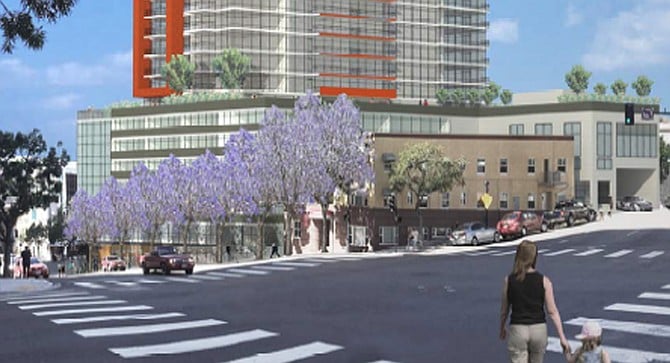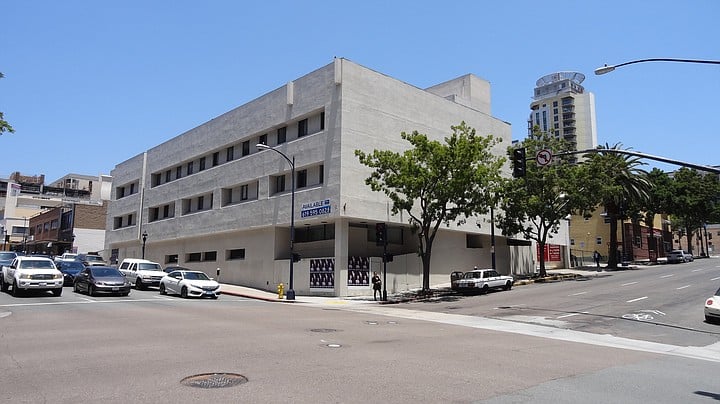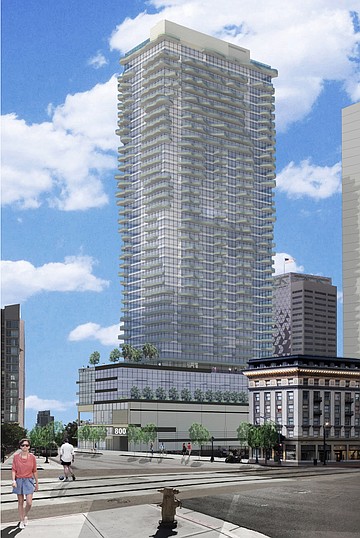 Facebook
Facebook
 X
X
 Instagram
Instagram
 TikTok
TikTok
 Youtube
Youtube

The boom in downtown apartment construction continues at a furious pace. Two more projects recently submitted their applications to Civic San Diego for the extensive approval process.

One new project will be just east of the long-planned massive Broadway Block development. The 800 Broadway project from Minto Investment Group, LLC, proposes a
40-story, mixed-use development with 384 dwelling units, approximately 21,000 square feet of retail space, and 358 parking spaces. The developer plans to include 34 affordable units.

That project is located on a 20,000-square-foot site on the north side of Broadway between Eighth and Ninth avenues in the East Village neighborhood. Per usual, there will be preliminary design review meetings followed by public meetings, then a final decision by the CivicSD board.

Meanwhile, Malek Investment Group, LLC proposes 6th & A, a 43-story, 401-foot-tall residential tower composed of 389 units, with 33 affordable ones. It would include 433 parking spaces. Their 29,750-square-foot site is located on the north side of A Street, between Sixth and Seventh avenues in the Cortez neighborhood. The multiple amenities include an open space for pets on the eighth floor, with a drainage section connected to the sewer system.
Such projects provide some affordable units (in lieu of paying the required inclusionary housing fee to the city). They offer a remedy to the spiraling cost of apartment rentals. "CivicSD strongly encourages developers to include affordable units rather than pay the fee, but a majority of projects still pay the fee," said Brad Richter, assistant VP of planning. But some industry experts contend these affordable units are insufficient.
Former CivicSD president Jeff Graham, now executive director of real estate at UCSD, told the Reader: “While developers providing 10-20 percent of inclusionary affordable units may not seem like enough (it’s not) to solve SD’s housing crisis for average workers, every little bit helps.” He elaborated: “Cities’ — not just SD’s but all cities in SD County — community plans desperately need to be updated with zoning along commercial corridors that allow for greater density, provided the project delivers high-quality design and respects the needs of the community in which it’s built.”
Gary Smith is president of the San Diego Downtown Residents Group. Regarding affordable units, Smith says, “It’s better included than [the developer] paying the fee; at least they will get built.”
Graham says moving up does create vacancies for others: “Delivering more moderately priced housing will allow average-wage-earning households to obtain new housing and vacate older housing that can become available to those households that may be living in subpar housing, homeless, or on the verge of homelessness.”


The boom in downtown apartment construction continues at a furious pace. Two more projects recently submitted their applications to Civic San Diego for the extensive approval process.

One new project will be just east of the long-planned massive Broadway Block development. The 800 Broadway project from Minto Investment Group, LLC, proposes a
40-story, mixed-use development with 384 dwelling units, approximately 21,000 square feet of retail space, and 358 parking spaces. The developer plans to include 34 affordable units.

That project is located on a 20,000-square-foot site on the north side of Broadway between Eighth and Ninth avenues in the East Village neighborhood. Per usual, there will be preliminary design review meetings followed by public meetings, then a final decision by the CivicSD board.

Meanwhile, Malek Investment Group, LLC proposes 6th & A, a 43-story, 401-foot-tall residential tower composed of 389 units, with 33 affordable ones. It would include 433 parking spaces. Their 29,750-square-foot site is located on the north side of A Street, between Sixth and Seventh avenues in the Cortez neighborhood. The multiple amenities include an open space for pets on the eighth floor, with a drainage section connected to the sewer system.
Such projects provide some affordable units (in lieu of paying the required inclusionary housing fee to the city). They offer a remedy to the spiraling cost of apartment rentals. "CivicSD strongly encourages developers to include affordable units rather than pay the fee, but a majority of projects still pay the fee," said Brad Richter, assistant VP of planning. But some industry experts contend these affordable units are insufficient.
Former CivicSD president Jeff Graham, now executive director of real estate at UCSD, told the Reader: “While developers providing 10-20 percent of inclusionary affordable units may not seem like enough (it’s not) to solve SD’s housing crisis for average workers, every little bit helps.” He elaborated: “Cities’ — not just SD’s but all cities in SD County — community plans desperately need to be updated with zoning along commercial corridors that allow for greater density, provided the project delivers high-quality design and respects the needs of the community in which it’s built.”
Gary Smith is president of the San Diego Downtown Residents Group. Regarding affordable units, Smith says, “It’s better included than [the developer] paying the fee; at least they will get built.”
Graham says moving up does create vacancies for others: “Delivering more moderately priced housing will allow average-wage-earning households to obtain new housing and vacate older housing that can become available to those households that may be living in subpar housing, homeless, or on the verge of homelessness.”
Comments